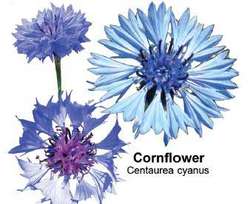cornflower
cornflower
Cornflower
(Centaurea), a genus of herbaceous plants of the family Compositae. The inflorescences (calathides) have bristly receptacles and tubular, varicolored flowers (purple, pink, blue, yellow); the marginal ones are sexless, and if enlarged, are shaped like tubular funnels. There are over 550 species in Eurasia, tropical Africa, and North and South America (Chile), and there is one species in Australia. The greatest number of representatives are in the Mediterranean and Near Eastern countries. In the USSR there are approximately 180 species; widely distributed (except in the Far North) are the blue cornflower (C. cyanus) and the meadow cornflower (C. jacea). The blue cornflower is a weed but is also a nectariferous and medicinal plant. Some cornflowers are grown as decorative plants.
REFERENCE
Flora SSSR, [vol.] 28. Moscow-Leningrad, 1963.M. E. KIRPICHNIKOV
